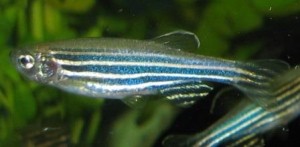 Dr. Steven Ripp, research associate professor at the Center for Environmental Biotechnology, will wrap up the Fall 2014 Science Forum series with his presentation: “Catch-of-the-day: The tiny zebrafish in the big pharmaceutical pond.” The final session will take place Friday, Nov. 21.
Dr. Steven Ripp, research associate professor at the Center for Environmental Biotechnology, will wrap up the Fall 2014 Science Forum series with his presentation: “Catch-of-the-day: The tiny zebrafish in the big pharmaceutical pond.” The final session will take place Friday, Nov. 21.
The zebrafish is a 1.5 inch long tropical freshwater fish belonging to the minnow family. It is a very popular aquarium fish due to its hardiness, ease of breeding and availability in nearly any pet store. Zebrafish are also becoming popular in the biomedical research community because they share nearly 12,800 genes in common with humans, 84 percent of which can be linked to genes that cause disease in humans. Thus, studying how zebrafish genes react and respond to new cancer drugs or other disease treatment strategies serves as an indicator of similar reaction endpoints in humans, and can be used to determine the safety and efficacy of drugs prior to human (or other animal) therapies.
Although the mouse served admirably as the proxy for human biomedical research for the past several decades, the small size and high fertility of zebrafish assists in reducing drug discovery costs and accelerating research results. More critically, the transparency of zebrafish early in their life cycle allows them to function as see-through subjects whose every organ and tissue can be easily visualized to better and more quickly understand how a new drug might be affecting, for example, the growth of a cancerous tumor.
To make zebrafish visualization even easier, Dr. Ripp’s research is focused on integrating genes into the zebrafish that will allow specific organs and tissues to emit bioluminescent light. Cameras able to capture this light response will very precisely monitor the zebrafish’s physiology to rapidly pinpoint the effectiveness of a new drug or, alternatively, determine unwanted side effects of a new drug. With the zebrafish being so small and large in number, many drugs can be tested simultaneously to massively accelerate the current pace of new drug discovery and move drugs to market faster and more inexpensively than previously possible.
The UT Science Forum is free and open to the public. Presentations begin at 12 p.m. in the Thompson-Boling Arena Cafe, rooms C-D.